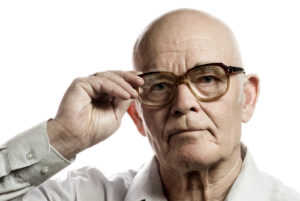
Signs of Eye Problems in Adults
Normally, eye problems are easy to spot in adults because adults are very vocal about their vision, unlike children and infants. As we age, it’s no secret that our vision changes, and adults are able to easily notice these changes as their quality of life decreases.
However, some eye issues could be brushed off by adults, and end up leading to horrible consequences. If you notice any changes in your vision, you should visit your eye doctor immediately. It’s crucial you allow a medical professional to determine the underlying problems with your eyes and vision. Here are a few warning signs of eye problems in adults:
Warning Signs

- Double vision
- Blurry vision
- Changes in your color vision
- Problems with glares from the sun or lamps
- Halos around lights
- Difficulty seeing things out of the side of your eyes
Common Eye Problems in Adults
If you are experiencing any of these symptoms, then you could be experiencing an age-related eye problem. Many problems with the eyes occur as we grow older. But they can be fixed through visits to the eye doctor or through eye exercises and natural vitamins. Some of the more common problems include cataracts, declining vision, eye floaters, dry eyes, and glaucoma. All these issues are highly treatable and should be spoken about with your optometrist.
Cataracts
Cataracts are extremely common as you age. Some eye surgeons even believe that every single person will get cataracts at some point in their lives. Cataracts are the clouding of your eye lens which causes blurry vision and glares around lights. People with cataracts might also have trouble telling colors apart and driving at night.
Glaucoma
Glaucoma is another common eye issue that can occur in aging people. The term glaucoma is used to describe multiple disorders that all involve elevated intraocular pressure.
If left untreated, the pressure in your eyes will continue to increase and can damage your vision permanently. There are a few natural ways to bring down eye pressure caused by glaucoma. One of which is cleaning up your diet and eating more fruits and vegetables.
Presbyopia
If you are having trouble seeing and have blurry vision, then you might be suffering from presbyopia. This impairment is marked by declining vision as you grow older. Because, as you age, your eyes age too. They will start showing signs of wear and tear from your entire life and can become tired.
Tired eyes can be overworked and can cause you to have blurry vision. Fortunately, blurry vision can be fixed through many vectors. The easiest way to fix blurry vision without having to start wearing glasses is to complete eye exercises to re-strengthen the muscles.
Nearsightedness
Another common eye condition in adults is nearsightedness, or myopia. In this condition, things far away appear blurry. Your up-close vision could be perfect but seeing anything in the distance is a challenge. Often, this is why adults wear glasses or contact lenses. They might use them for driving and watching TV, but not for reading a book or texting.
You aren’t doomed to a life of glasses or lenses with myopia, though. There are plenty of natural solutions to improve your vision over time. They aren’t fast solutions, but they are effective. One method is practicing eye exercises for nearsightedness. These stretches train the eyes’ muscles to focus on objects in the distance. For example, the 10-10-10 Rule. In this exercise, you focus on an object 10 feet away for 10 seconds, every 10 minutes. This forces you to take a break from close work and stretch your eye muscles.
Farsightedness
The other reason many adults wear glasses is farsightedness, or hyperopia. In this condition, you may be able to see clearly at a distance. But objects that are near you become blurry. This makes texting, reading, and doing near work like sewing difficult. Often, adults will buy generic reading glasses that don’t match their prescription but are “good enough.” Not only will this not improve your vision, but your vision could continue to get worse.
It’s important you take your vision into your own hands. If you want to stop dealing with farsightedness, start doing eye exercises for farsightedness. Some examples of these are palming, blinking, resting, and The William Bates Method.
Astigmatism
If you wear corrective glasses or lenses, you may have heard the term astigmatism. Twenty-eight percent of American children have one, and many don’t fix it before adulthood. Astigmatism is when you have an irregularly shaped cornea. One eye could have astigmatism which means you’ll have different prescriptions in each eye.
Adults with this condition in one eye should practice eye exercises specifically for astigmatism. Some good ones to try are the Varying Focus Exercise and the Head Checking. In the Head Checking exercise, you simply ask a friend or family member to point out when your head is tilting. Tilting is a common habit for those with astigmatism. One way to treat it is to resist the tilt and train your eyes to focus directly ahead.
How to Help
If you are experiencing blurry vision and don’t want to be impeded by glasses or contacts, look at natural alternatives. Your diet makes a huge impact on the quality of your vision. And, it affects the overall health of your eyes. If you want to treat your vision problems, start by assessing what you’re putting in your body. Each day, you need to get a full dose of antioxidants, minerals, and hydration. Within those categories are nutrients like vitamins, zinc, iron, and other micro-nutrients.
Yes, meal planning each day to include all these nutrients can be challenging. Instead, you might want to consider eye vitamins like the Ocu-Plus Formula. Our proven combination of eye-healthy vitamins, minerals and nutrients will help improve vision acuity without the use of pharmaceuticals or corrective lenses.
Your eyes are overworked and tired, and as you age, they get worse. This leads to blurry vision and declining vision. But the good news is that you can revitalize your eyes with the right vitamins.
Our Rebuild Your Vision Ocu-Plus Formula Contains All 17 Vitamins, Minerals, and Herbal Supplements to Improve Your Eye Health!












It really helped me when you enumerated the different signs that say that there’s a problem with a person’s eyes, but what caught my attention was the blurring of the vision, sensitivity to glares, and limit of the peripheral vision. I have been noticing that for me for a while now, but I was ignoring it thinking that it’s nothing that I should be worrying about. But when I saw this article, I realized that my notion was wrong. It may be for the best that I get in touch with an eye professional right away. Thank you.